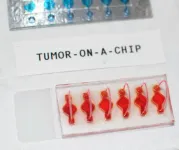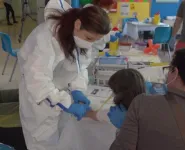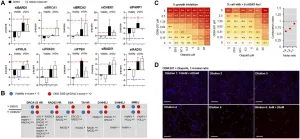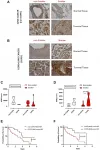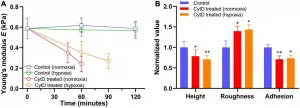(Press-News.org) WINSTON-SALEM, NC, JULY 19, 2021 -- Wake Forest researchers and clinicians are using patient-specific tumor 'organoid' models as a preclinical companion platform to better evaluate immunotherapy treatment for appendiceal cancer, one of the rarest cancers affecting only 1 in 100,000 people. Immunotherapies, also known as biologic therapies, activate the body's own immune system to control, and eliminate cancer.
Appendiceal cancer is historically resistant to systemic chemotherapy, and the effect of immunotherapy is essentially unknown because clinical trials are difficult to perform due to lack of adequate patient numbers, resulting in a lack of data and limited research models.
Researchers at the Wake Forest Organoid Research Center (WFORCE), a joint venture between the Wake Forest Institute for Regenerative Medicine (WFIRM), and the Wake Forest Comprehensive Cancer Center, were the first to create appendiceal cancer organoids to use as a predictive model for potential treatment options (published 2018). The Comprehensive Cancer Center is a major high volume center with a global reputation in the treatment of appendiceal cancer.
These cancer organoids are part of WFIRM's "Body-on-a-Chip" system that allows scientists to engineer the organoids, or human tissue equivalents, that function in a very similar manner as actual human tissues and organs.
In this new study, published in the journal Clinical Cancer Research, their results indicate that various types immunotherapies tested on the organoids can potentially support treatment decisions and can achieve personalized results, identifying beneficial treatments while sparing patients from harmful side effects of drugs for which they will obtain no benefit.
"For this study we reconstructed patients' tumors as organoids, supercharged with a built-in immune system directly obtained from the patient," said senior author Konstantinos I. Votanopoulos, MD, PhD, professor of surgery at the Comprehensive Cancer Center and co-director of WFORCE. "In this way we created a personalized interface to study how effective the immunotherapy drugs are in activating a patient's own immune system to kill the cancer. This platform is breaking new ground for appendiceal cancer, and it can also be applied in research for other rare cancers where preclinical models are lacking."
This research study utilizes the WFIRM's "Body-on-a-Chip" system that allows scientists to engineer the organoids, or humanoid tissue equivalents, that function in a very similar manner as actual human organs.
Cells from tumor biopsies from 26 patients were obtained to grow the organoids - tiny, 3D tissue-like structures, in the lab that that mimic the cancerous tumors. The immune enhanced tumor organoids were treated with one of three immunotherapy drugs and then assessed for responsiveness.
"In the future, by verifying that that the tumor and its organoids behave in the same fashion, we could modify clinical trial design and optimize cost by targeting patients with organoids that have exhibited favorable results," Votanopoulos said.
Current strategies to understand tumor progression center on analyses of the tumor cells in isolation, but do not capture the interactions between a tumor and its surrounding space, known as the microenvironment or stroma. This leads to inaccuracies in predicting tumor progression and chemotherapy or immunotherapy response. Patient-derived tumor organoids are used as a testing and predicting platform to model diseases, evaluate efficacy and/or toxicity of new and existing drugs, and can be used to test environmental hazards.
Co-author Shay Soker, PhD, professor of regenerative medicine who leads tumor organoid research at WFIRM and co-directs WFORCE, said new technologies and biological models that improve prognostication will have a significant effect on patient mortality. "Using the organoids as a preclinical platform can lead to development of novel therapeutics which target and control tumor cells specifically, sparing healthy tissue from the side effects of chemotherapy and immunotherapy treatments," he said. "For rare cancers like appendiceal cancer, this technology can make a difference in overall quality of life for patients."
INFORMATION:
Additional co-authors include: Steven D Forsythe, MS, Richard A Erali, MD, Shyama Sasikumar, MS, Preston Laney, BS, Ethan Shelkey, BS, all of WFIRM; and Ralph D'Agostino Jr, PhD, Lance D Miller, PhD, Perry Shen, MD, and Edward A Levine, MD, all of the Comprehensive Cancer Center. The author's report no conflicts of interest.
Research support provided by: the Wake Forest Dean's Hero Award, the Appendix Cancer Pseudomyxoma Peritonei Foundation, the National Organization of Rare Diseases, and the National Institute of Health. Results were first presented at the Society of Surgical Oncology Annual Meeting, March 2021.
About the Wake Forest Institute for Regenerative Medicine: The Wake Forest Institute for Regenerative Medicine is recognized as an international leader in translating scientific discovery into clinical therapies, with many world firsts, including the development and implantation of the first engineered organ in a patient. Over 400 people at the institute, the largest in the world, work on more than 40 different tissues and organs. A number of the basic principles of tissue engineering and regenerative medicine were first developed at the institute. WFIRM researchers have successfully engineered replacement tissues and organs in all four categories - flat structures, tubular tissues, hollow organs and solid organs - and 15 different applications of cell/tissue therapy technologies, such as skin, urethras, cartilage, bladders, muscle, kidney, and vaginal organs, have been successfully used in human patients. The institute, which is part of Wake Forest School of Medicine, is located in the Innovation Quarter in downtown Winston-Salem, NC, and is driven by the urgent needs of patients. The institute is making a global difference in regenerative medicine through collaborations with over 400 entities and institutions worldwide, through its government, academic and industry partnerships, its start-up entities, and through major initiatives in breakthrough technologies, such as tissue engineering, cell therapies, diagnostics, drug discovery, biomanufacturing, nanotechnology, gene editing and 3D printing.
About Wake Forest Organoid Research Center: The Wake Forest Organoid Research Center (WFORCE) is a joint effort between the Wake Forest Institute for Regenerative Medicine and the Wake Forest Comprehensive Cancer Center and brings together researchers and clinicians, who are working side by side, to leverage the use of tissue organoid technology for the benefit of patients.
COLUMBUS, Ohio - When COVID-19 hit, affluent Columbus residents responded by taking significantly fewer trips to large grocery and big-box stores, apparently ordering more online and stocking up when they did go out to shop.
With fewer options available to them, low-income people had to double down on what they had always done: regular trips to the local dollar stores and small groceries to get their family's food.
That's the conclusion of a new study that analyzed traffic to Columbus grocery sellers before, during and after the COVID-19 lockdown.
Dollar stores and small local grocers in neighborhoods housing mostly low-income people of color didn't see as much of a decline in customers during the lockdown as did large grocery and big-box stores, ...
Tokyo, Japan - Designing materials that have the necessary properties to fulfill specific functions is a challenge faced by researchers working in areas from catalysis to solar cells. To speed up development processes, modeling approaches can be used to predict information to guide refinements. Researchers from The University of Tokyo Institute of Industrial Science have developed a machine learning model to determine characteristics of bonded and adsorbed materials based on parameters of the individual components. Their findings are published in Applied Physics Express.
Factors such as the length and strength of bonds in materials play ...
Testing of an entire Italian town shows antibody levels remain high nine months after SARS-CoV-2 infection, whether symptomatic or asymptomatic.
Researchers from the University of Padua and Imperial College London tested more than 85 percent of the 3,000 residents of Vo', Italy, in February/March 2020 for infection with SARS-CoV-2, the virus that causes COVID-19, and tested them again in May and November 2020 for antibodies against the virus.
The team found that 98.8 percent of people infected in February/March showed detectable levels of antibodies in November, and there was no difference between people who had suffered symptoms of COVID-19 and those that had been symptom-free. The results are ...
Why do alterations of certain genes cause cancer only in specific organs of the human body? Scientists at the German Cancer Consortium (DKTK), the Technical University of Munich (TUM), and the University Medical Center Göttingen have now demonstrated that cells originating from different organs are differentially susceptible to activating mutations in cancer drivers: The same mutation in precursor cells of the pancreas or the bile duct leads to fundamental different outcomes. The team discovered for the first time that tissue specific genetic interactions are responsible for the differential susceptibility of the biliary and the pancreatic epithelium towards ...
The climate crisis will lead to changes in distribution and habitat loss of stony corals in the tropical Atlantic, shows a new study published by the open access publisher Frontiers. The loss of such coral species could have devastating consequences for the marine ecosystems they inhabit. The results of the study highlight an urgent need for coral reef management in the Atlantic.
Researchers at the University of São Paulo projected current and future distributions of three key reef building corals of the tropical Atlantic (Mussismilia hispida, Montastraea cavernosa and the Siderastrea complex). They ...
To prepare for the next pandemic and provide a coordinated approach to vaccination across the country, Canada should create Canadian Immunization Services based on the Canadian Blood Services model, authors propose in CMAJ (Canadian Medical Association Journal).
The authors, including a leading health policy and immunization expert, a blood system expert and a former federal minister of health, are Dr. Kumanan Wilson, professor, Department of Medicine and member of the Centre for Health Law, Policy and Ethics, University of Ottawa; Dr. Graham Sher, CEO, Canadian Blood Services; and Dr. Jane Philpott, Dean, Faculty of Health Sciences, Queen's University.
"If we want to be better prepared for the ...
Philadelphia, July 19, 2021 - University of Minnesota School of Public Health researchers recently completed a study to determine how food-insecure young (emerging) adults (18-29 years of age) adapted their eating and child feeding behaviors during the COVID-19 pandemic. The researchers also sought to identify barriers to food access and opportunities to improve local access to resources for emerging adults. Their END ...
Oncotarget published "Ex vivo analysis of DNA repair targeting in extreme rare cutaneous apocrine sweat gland carcinoma" which reported a rare metastatic case with a PALB2 aberration identified previously as a familial susceptibility gene for breast cancer in the Finnish population.
As PALB2 exhibits functions in the BRCA1/2-RAD51-dependent homologous DNA recombination repair pathway, we sought to use ex vivo functional screening to explore sensitivity of the tumor cells to therapeutic targeting of DNA repair.
Drug screening suggested sensitivity of the PALB2 deficient cells to BET-bromodomain inhibition, and modest ...
Oncotarget published "Caspase-11 and AIM2 inflammasome are involved in smoking-induced COPD and lung adenocarcinoma" which reported that cigarette smoking is the leading risk factor for COPD and lung cancer establishment.
Epidemiologically, COPD patients are 6.35 times more likely to develop lung cancer.
To mimic COPD, the authors exposed mice to nose-only cigarette smoke and used human samples of lung adenocarcinoma patients according to the smoking and COPD status.
Interestingly, higher expression of AIM2 in non-cancerous tissue of smoking COPD adenocarcinoma patients was correlated to a higher hazard ratio of poor survival ...
Oncotarget published "Dynamic cellular biomechanics in responses to chemotherapeutic drug in hypoxia probed by atomic force spectroscopy" which reported that by exploiting single-cell, force spectroscopy methods, the authors probed biophysical and biomechanical kinetics of brain, breast, prostate, and pancreatic cancer cells with standard chemotherapeutic drugs in normoxia and hypoxia over 12-24 hours.
After exposure to the drugs, they found that brain, breast, and pancreatic cancer cells became approximately 55-75% less stiff, while prostate cancer cells became more stiff, due to either drug-induced ...
